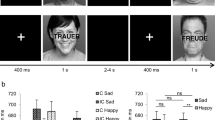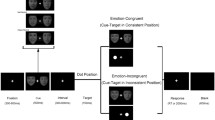Abstract
Lack of positive emotion is considered an important aspect of depression. Previous studies have reported decreased attention to positive information for individuals with depressive symptoms; however, such studies have not investigated whether decreased attentional allocation occurs even when participants are required to fixate centrally on items presented in the visual field. In the present study, the attentional window (i.e., the spatial distribution of attentional resources) was measured with a modified version of the digit-parity task. In this task, the participants had to fixate on the centrally presented emotional face stimuli, and they were required to respond to the peripherally presented targets. The results indicated that individuals with higher levels of depressive symptoms were slower to respond when a target appeared near happy faces, which suggested decreased allocation of attention. Moreover, decreased allocation of attention to positive faces was found only in depressive individuals, not in individuals with social anxiety. The present findings suggest that individuals with higher levels of depressive symptoms allocate less attentional resources to positive stimuli, even when they are required to attend to them.


Similar content being viewed by others
Notes
Stimuli number A-1-06, C-2-18, EM-4-07, JB-1-09, NR-1-06, PE-2-12, SW-3-09, and WF-2-12 were chosen for positive stimuli; and A-1-02, C-2-03, EM-2-04, JB-1-03, NR-1-03, PE-2-04, SW-3-03, and WF-2-05 for neutral stimuli.
References
American Psychiatric Association. (2013). Diagnostic and statistical manual of mental disorders(DSM-5®). Arlington: American Psychiatric Publishing.
Armstrong, T., & Olatunji, B. O. (2012). Eye tracking of attention in the affective disorders: A meta-analytic review and synthesis. Clinical Psychology Review, 32(8), 704–723.
Baert, S., De Raedt, R., Schacht, R., & Koster, E. H. (2010). Attentional bias training in depression: Therapeutic effects depend on depression severity. Journal of Behavior Therapy and Experimental Psychiatry, 41(3), 265–274.
Beck, A. T. (1967). Depression: Clinical, experimental, and theoretical aspects. New York: Hoeber Medical Division, Harper & Row.
Beck, A. T. (1976). Cognitive therapy and the emotional disorders. New York, NY: Meridian.
Beck, A. T., Steer, R. A., & Brown, G. K. (1996). Manual for the Beck Depression Inventory-II. San Antonio, TX: Psychological Corporation.
Beevers, C. G., & Carver, C. S. (2003). Attentional bias and mood persistence as prospective predictors of dysphoria. Cognitive Therapy and Research, 27(6), 619–637. https://doi.org/10.1023/A:1026347610928.
Belzung, C., Willner, P., & Philippot, P. (2015). Depression: From psychopathology to pathophysiology. Current Opinion in Neurobiology, 30, 24–30.
Boettcher, J., Leek, L., Matson, L., Holmes, E. A., Browning, M., MacLeod, C., Andersson, G., & Carlbring, P. (2013). Internet-based attention bias modification for social anxiety: A randomised controlled comparison of training towards negative and training towards positive cues. PLoS One, 8(9), e71760.
Bradley, B. P., Mogg, K., & Millar, N. H. (2000). Covert and overt orienting of attention to emotional faces in anxiety. Cognition & Emotion, 14(6), 789–808.
Carleton, R. N., Collimore, K. C., McCabe, R. E., & Antony, M. M. (2011). Addressing revisions to the brief fear of negative evaluation scale: Measuring fear of negative evaluation across anxiety and mood disorders. Journal of Anxiety Disorders, 25(6), 822–828.
Caseras, X., Garner, M., Bradley, B. P., & Mogg, K. (2007). Biases in visual orienting to negative and positive scenes in dysphoria: An eye movement study. Journal of Abnormal Psychology, 116(3), 491–497.
Clark, L. A., & Watson, D. (1991). Tripartite model of anxiety and depression: Psychometric evidence and taxonomic implications. Journal of Abnormal Psychology, 100, 316–336.
Cristea, I. A., Kok, R. N., & Cuijpers, P. (2015, January 2). Efficacy of cognitive bias modification interventions in anxiety and depression: Meta-analysis. British Journal of Psychiatry. Cambridge University Press, 206, 7–16. https://doi.org/10.1192/bjp.bp.114.146761.
Deldin, P. J., Keller, J., Gergen, J. A., & Miller, G. A. (2000). Right-posterior face processing anomaly in depression. Journal of Abnormal Psychology, 109(1), 116–121.
Disner, S. G., Beevers, C. G., Haigh, E. A., & Beck, A. T. (2011). Neural mechanisms of the cognitive model of depression. Nature Reviews Neuroscience, 12(8), 467–477.
Ekman, P., & Friesen, W. V. (1976). Pictures of facial affect. Alto, CA: Consulting Psychologists Press.
Eriksen, C. W., & St. James, J. D. (1986). Visual attention within and around the field of focal attention: A zoom lens model. Perception & Psychophysics, 40(4), 225–240. https://doi.org/10.3758/BF03211502.
Eriksen, C. W., & Yeh, Y.-Y. (1985). Allocation of attention in the visual field. Journal of Experimental Psychology: Human Perception and Performance, 11(5), 583–597. https://doi.org/10.1037/0096-1523.11.5.583.
Fernandes, M. A., Koji, S., Dixon, M. J., & Aquino, J. M. (2011). Changing the focus of attention: The interacting effect of valence and arousal. Visual Cognition, 19(9), 1191–1211. https://doi.org/10.1080/13506285.2011.618151.
Gotlib, I. H., Kasch, K. L., Traill, S., Arnow, B. A., Joormann, J., & Johnson, S. L. (2004). Coherence and specificity of information-processing biases in depression and social phobia. Journal of Abnormal Psychology, 113(3), 386–398. https://doi.org/10.1037/0021-843X.113.3.386.
Grafton, B., Mackintosh, B., Vujic, T., & MacLeod, C. (2014). When ignorance is bliss: Explicit instruction and the efficacy of CBM-A for anxiety. Cognitive Therapy and Research, 38(2), 172–188.
Grafton, B., MacLeod, C., Rudaizky, D., Holmes, E. A., Salemink, E., Fox, E., & Notebaert, L. (2017). Confusing procedures with process when appraising the impact of cognitive bias modification on emotional vulnerability. The British Journal of Psychiatry, 211(5), 266–271.
Hakamata, Y., Lissek, S., Bar-Haim, Y., Britton, J. C., Fox, N. A., Leibenluft, E., & Pine, D. S. (2010). Attention bias modification treatment: A meta-analysis toward the establishment of novel treatment for anxiety. Biological Psychiatry, 68(11), 982–990. https://doi.org/10.1016/j.biopsych.2010.07.021.
Hoffman, J. E., & Subramaniam, B. (1995). The role of visual attention in saccadic eye movements. Perception & Psychophysics, 57(6), 787–795.
Hüttermann, S., & Memmert, D. (2017). The attention window: A narrative review of limitations and opportunities influencing the focus of attention. Research Quarterly for Exercise and Sport, 88(2), 169–183.
Ingram, R. E. (1984). Toward an information-processing analysis of depression. Cognitive Therapy and Research, 8(5), 443–477.
Joormann, J., Talbot, L., & Gotlib, I. H. (2007). Biased processing of emotional information in girls at risk for depression. Journal of Abnormal Psychology, 116(1), 135–143. https://doi.org/10.1037/0021-843X.116.1.135.
Kellough, J. L., Beevers, C. G., Ellis, A. J., & Wells, T. T. (2008). Time course of selective attention in clinically depressed young adults: An eye tracking study. Behaviour Research and Therapy, 46(11), 1238–1243. https://doi.org/10.1016/j.brat.2008.07.004.
Koster, E. H., Crombez, G., Verschuere, B., & De Houwer, J. (2004). Selective attention to threat in the dot probe paradigm: Differentiating vigilance and difficulty to disengage. Behaviour Research and Therapy, 42(10), 1183–1192.
Krebs, G., Hirsch, C. R., & Mathews, A. (2010). The effect of attention modification with explicit vs. minimal instructions on worry. Behaviour Research and Therapy, 48(3), 251–256.
Leary, M. R. (1983). A brief version of the fear of negative evaluation scale. Personality and Social Psychology Bulletin, 9(3), 371–375. https://doi.org/10.1177/0146167283093007.
LeMoult, J., Joormann, J., Sherdell, L., Wright, Y., & Gotlib, I. H. (2009). Identification of emotional facial expressions following recovery from depression. Journal of Abnormal Psychology, 118(4), 828–833.
Lewinsohn, P. M., Zinbarg, R., Seeley, J. R., Lewinsohn, M., & Sack, W. H. (1997). Lifetime comorbidity among anxiety disorders and between anxiety disorders and other mental disorders in adolescents. Journal of Anxiety Disorders, 11(4), 377–394. https://doi.org/10.1016/S0887-6185(97)00017-0.
Mogg, K., Waters, A. M., & Bradley, B. P. (2017). Attention Bias modification (ABM): Review of effects of multisession ABM training on anxiety and threat-related attention in high-anxious individuals. Clinical Psychological Science, 5(4), 698–717. https://doi.org/10.1177/2167702617696359.
Moriya, J., & Tanno, Y. (2010). Attentional resources in social anxiety and the effects of perceptual load. Cognition and Emotion, 24(8), 1329–1348. https://doi.org/10.1080/02699930903378503.
Müller, M. M., & Hübner, R. (2002). Can the spotlight of attention be shaped like a doughnut? Evidence from steady-state visual evoked potentials. Psychological Science, 13(2), 119–124. https://doi.org/10.1111/1467-9280.00422.
Nishiguchi, Y., Takano, K., & Tanno, Y. (2015). Explicitly guided attentional bias modification promotes attentional disengagement from negative stimuli. Emotion, 15(6), 731–741.
Peckham, A. D., McHugh, R. K., & Otto, M. W. (2010). A meta-analysis of the magnitude of biased attention in depression. Depression and Anxiety, 27(12), 1135–1142. https://doi.org/10.1002/da.20755.
Radloff, L. S. (1977). The CES-D scale a self-report depression scale for research in the general population. Applied Psychological Measurement, 1(3), 385–401.
Sasagawa, S., Kanai, Y., Marunaka, Y., Suzuki, S., Shimada, H., & Sakano, Y. (2004). Development of a short fear of negative evaluation scale for Japanese using item response theory. Japanese Journal of Behavior Therapy, 30, 87–98.
Sears, C. R., Newman, K. R., Ference, J. D., & Thomas, C. L. (2011). Attention to emotional images in previously depressed individuals: An eye-tracking study. Cognitive Therapy and Research, 35(6), 517–528. https://doi.org/10.1007/s10608-011-9396-5.
Sears, C. R., Thomas, C. L., Lehuquet, J. M., & Johnson, J. C. S. (2010). Attentional biases in dysphoria: An eye-tracking study of the allocation and disengagement of attention. Cognition and Emotion, 24(8), 1349–1368. https://doi.org/10.1080/02699930903399319.
Shima, S., Shikano, T., Kitamura, T., & Asai, M. (1985). Reliability and validity of CES-D. Clinical Psychiatry, 27(6), 717–723.
Surguladze, S. A., Young, A. W., Senior, C., Brébion, G., Travis, M. J., & Phillips, M. L. (2004). Recognition accuracy and response bias to happy and sad facial expressions in patients with major depression. Neuropsychology, 18(2), 212–218.
Trew, J. L. (2011). Exploring the roles of approach and avoidance in depression: An integrative model. Clinical Psychology Review, 31(7), 1156–1168.
Wells, A. (1990). Panic disorder in association with relaxation induced anxiety: An attentional training approach to treatment. Behavior Therapy, 21(3), 273–280.
Wells, T. T., & Beevers, C. G. (2010). Biased attention and dysphoria: Manipulating selective attention reduces subsequent depressive symptoms. Cognition & Emotion, 24(4), 719–728. https://doi.org/10.1080/02699930802652388.
Wisco, B. E. (2009). Depressive cognition: Self-reference and depth of processing. Clinical Psychology Review, 29(4), 382–392. https://doi.org/10.1016/j.cpr.2009.03.003.
Wolford, G., & Morrison, F. (1980). Processing of unattended visual information. Memory & Cognition, 8(6), 521–527. https://doi.org/10.3758/BF03213771.
Zvielli, A., Vrijsen, J. N., Koster, E. H. W., & Bernstein, A. (2016). Attentional bias temporal dynamics in remitted depression. Journal of Abnormal Psychology, 125(6), 768–776. https://doi.org/10.1037/abn0000190.
Funding
This research was supported by the Grant-in-Aid for Japan Society for the Promotion of Science (JSPS) Fellows (13J08747) and Grant-in-Aid for Research Activity Start-up (16H06707) awarded to Yuki Nishiguchi by the JSPS.
Author information
Authors and Affiliations
Corresponding author
Ethics declarations
Conflict of Interest
On behalf of all authors, the corresponding author states that there is no conflict of interest.
Ethics Approval
This study was approved by the ethics committee of the university of Tokyo (issue number: 364).
Informed Consent
Informed consent was obtained from all the participants in the present study.
Additional information
Publisher’s Note
Springer Nature remains neutral with regard to jurisdictional claims in published maps and institutional affiliations.
Rights and permissions
About this article
Cite this article
Nishiguchi, Y., Tanno, Y. Decreased attentional allocation to centrally presented positive stimuli in individuals with depressive symptoms. Curr Psychol 42, 914–922 (2023). https://doi.org/10.1007/s12144-021-01496-y
Accepted:
Published:
Issue Date:
DOI: https://doi.org/10.1007/s12144-021-01496-y




